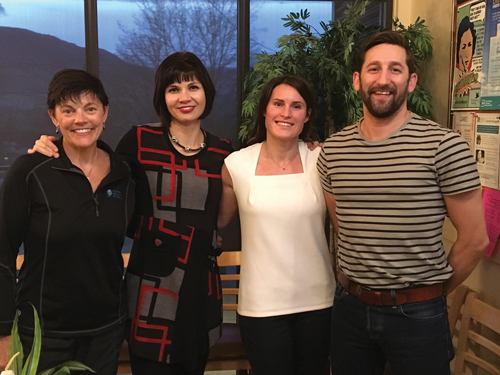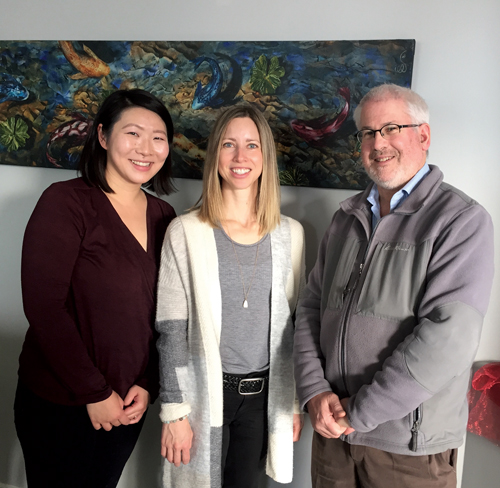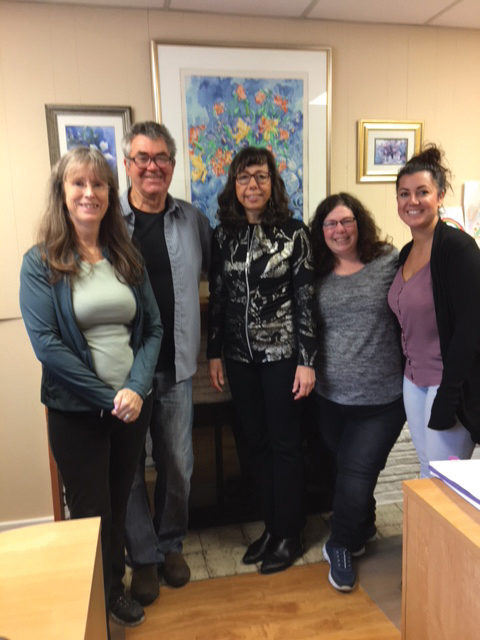Winter 2017 (Volume 27, Number 4)
Updates from British Columbia
Update From the Okanagan
Download PDF
We have six rheumatologists in the Okanagan, who are all extremely busy with long waiting lists, and are pleased to have a seventh rheumatologist just starting practice in Kelowna. We all have nurses working with us to assist with patient care. Dr. Stuart Seigel and Dr. Anick Godin are very pleased to welcome Dr. Evelyn Kwok to Kelowna, who will be working in their office. Evelyn will have her hands full with her seven-monthold son and establishing a new practice. Dr. Seigel and Dr. Godin are interested in teaching and have been running an elective for teaching Rheumatology Fellows. Dr. Dan Mcleod continues to provide clinics in Whitehorse, Yukon. Dr. Nima Shojania works in West Kelowna and also does outreach clinics in Dawson Creek and Fort St. John, which he finds very rewarding.
Dr Shojania and Dr. Godin also have a joint osteoporosis clinic. In Penticton, Dr. Michelle Teo works with a team of two nurses, which has allowed her to double the number of patient visits per year with their model of care. Dr. Michelle Teo also is interested in research and is the recipient of a two-year CIORA grant looking at a community-based multidisciplinary model of care for treatment of fibromyalgia. She is also interested in developing a fracture liaison service (FLS). I continue to be extremely busy in my role as President of the Medical Staff Association in Penticton, in addition to running a very full practice. I also do four clinics per year in Princeton, British Columbia, for patients who have difficulty with travelling and hold a once monthly osteoporosis clinic. In Penticton, we are most fortunate to have the Mary Pack Arthritis Program at our hospital, providing physiotherapy and occupational therapy services to our arthritis patients. We all enjoy the wonderful outdoor activities the Okanagan has to offer: Ski season is starting and we can’t wait to get into that Okanagan powder, but many of us also enjoy the excellent cycling, hiking, and swimming this area has to offer.

Team Teo.

Drs. Kwok, Godin, and Seigel.

Team Stewart and the Infusion Clinic.
Jackie Stewart, BSc (Hons), B ED, MD, FRCPC
Clinical Assistant Professor,
Department of Medicine,
University of British Columbia,
Rheumatologist,
Penticton Regional Hospital
Penticton, British Columbia
Update From Kamloops
Download PDF
My sister and I took my nieces to the Vernon waterslides the first day of the school summer vacation. It was a glorious day and we all left with the mantra we were “going to have the best summer ever.” And then, British Columbia (B.C.) began to burn. It burned for the entire summer and well into September 2017. Nearly 900,000 hectares burned and more than 39,000 B.C. residents were evacuated.
By chance, I was in Cache Creek an hour before it was evacuated due to an explosive and aggressive fire. The entire hillsides surrounding the highway were on fire and the highway and sky were streaked with red from the fire retardant dropped by the bombers. It was an eerily beautiful sight and a clear declaration of what the summer of 2017 would be.
About one third of my practice was evacuated. This lead to interesting social situations. One of my patients was travelling and couldn’t return to Williams Lake. He ended up in Kamloops with the dog, while his wife was in Quesnel with the cat. Due to road closures and poor visibility grounding flights, it was days until they were reunited.
Thompson Rivers University and our major arenas became evacuation centres complete with army cots. Many local residents took in complete strangers. I was very impressed by my physician colleagues who were willing to take in displaced physicians they didn’t know and even their horses, etc. Kamloops was home to about 10,000 evacuees. My patients were so impressed with how well they were treated and the events that were organized for their entertainment and by the fundraisers and donations received.
The evacuations lead to some pretty interesting patient situations. One evacuated nurse practitioner was doing “hotel calls” to provide patient care. I drew the line at a new start gold injection though and yes, we do on occasion, use gold in B.C.! An evacuated physician ran a clinic for evacuees and our health authority extended privileges to evacuate physicians so they could still work while displaced.
Our air quality was hideous. On an air quality health index scale that usually goes from 1 to 7, we spent days in the 40s and 50s. I couldn’t see the street from my office window, and some mornings I could see about 4 feet in front of my car. Our air quality was consistently worse than Beijing with a corresponding upswing in respiratory illnesses.
The ranchers were particularly devastated with the loss of cattle due to burned fences, loose cattle being chased off the highways and back into the fire zone, and destruction of grazing land. In typical rural fashion those who have intact pastures are caring for other farmers’ cattle.
While the worst of the fire season is over, many continue to burn underground. We are hoping for a very cold winter with a lot of snow, so the fires will extinguish over the winter. We hope to be in the news next summer for our scenic surroundings rather then our raging fires.
Barb Blumenauer, MD, FRCPC
Rheumatologist,
Royal Inland Hospital
Kamloops, British Columbia
|
